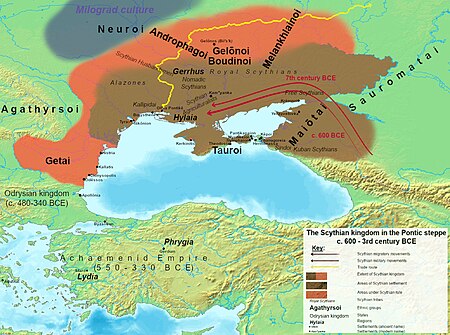Neuri

TheNeuriorNavari(Ancient Greek:Νευροὶ,romanized:Neuroi;Latin:Neuri) were an ancientBalticpeople whose existence was recorded by ancientGraeco-Romanauthors.
Identification[edit]
The Neuri belonged to a larger group ofBaltic peoplesof which the only present-day members areLithuaniansandLatvians.[1]
The Neuri lived in the region corresponding to present-dayBelarus,[1]in the territory including theDesna,Pripyat,and middleDnieperrivers. To the south, the territory of the Neuri reached the upper section of theSouthern Buhriver.[2]
The neighbours of the Neuri to the east of the Dnieper river were theAndrophagi,theMelanchlaeni,[3]and theBudinias well asFinno-Ugric peoples.[4]Their neighbours were theAgathyrsito the south-west,[2]and theScythian[1]tribe of the Aroteres to the south-east.[2][5]
History[edit]
The Neuri were independent of the Scythians.[3]
According to Herodotus of Halicarnassus, the Neuri once had to leave their country because of an invasion of snakes.[6]
When thePersianAchaemenidkingDarius Iattacked the Scythiansin 513 BC, the Scythian kingIdanthyrsussummoned the kings of the peoples surrounding his kingdom to a meeting to decide how to deal with the Persian invasion. The kings of theBudini,GeloniansandSarmatiansaccepted to help the Scythians against the Persian attack, while the kings of theAgathyrsi,Androphagi,Melanchlaeni,Neuri, andTaurirefused to support the Scythians.[7]
During the campaign, the Scythians and the Persian army pursuing them passed through the territories of the Melanchlaeni, Androphagi, and Neuri, before they reached the borders of the Agathyrsi, who refused to let the Scythian divisions to pass into their territories and find refuge there, thus forcing the Scythians to return toScythiawith the Persians pursuing them.[8][7]
Legacy[edit]
The Neuri have left traces of their presence in the region of theDesna,Pripyat,and middleDnieperrivers in the form ofBaltic-derived hydronyms and typonyms which pre-date the migration ofSlavic peoplesinto this area.[2]
Society[edit]
Culture[edit]
According to the Greek authorHerodotus of Halicarnassus,the Neuri followed Scythian customs. This claim might have referred only to the southernmost sections of the Neuri, who were neighbours of the Scythian Aroteres tribe.[2]
Herodotus also claimed that the Neuri "seemed to be magicians," and that all members of their tribe would allegedly each yearbecome a wolffor some days before being restored to their human form.[5]This might suggest that the Neuri performed cults in which they wore wolf skins and masks, and that the wolf might have been atotemanimal of this tribe.[6]
Archaeology[edit]
The Neuri archaeologically correspond to theMilograd culture.[2][5]
The southernmost of part of the Milograd culture, which adjoined the territory of the Scythian Aroteres, included many Scythian elements.[2]
References[edit]
- ^abcSulimirski 1985,p. 153.
- ^abcdefgSulimirski 1985,p. 184.
- ^abSulimirski 1985,p. 185.
- ^Sulimirski 1985,p. 183.
- ^abcSulimirski & Taylor 1991,p. 585.
- ^abParzinger 2004,p. 72-73.
- ^abHerodotus & Godolphin 1973.
- ^Fol & Hammond 1988,p. 241.
Sources[edit]
- Fol, Alexander;Hammond, N. G. L.(1988). "Persia in Europe, Apart from Greece". InBoardman, John;Hammond, N. G. L.;Lewis, D. M.;Ostwald, M.(eds.).Persian, Greece and the Western Mediterranean, c. 525 to 479 B.C.The Cambridge Ancient History.Vol. 4.Cambridge:Cambridge University Press.pp. 234–253.ISBN978-0-521-22804-6.
- Herodotus;Godolphin, Francis R. B. (1973)."Herodotus: On the Scythians".The Metropolitan Museum of Art Bulletin.32(5): 129–149.doi:10.2307/3269235.JSTOR3269235.Retrieved26 November2021.
- Parzinger, Hermann(2004).Die Skythen[The Scythians] (in German).Munich,Germany:Verlag C.H.Beck.ISBN978-3-406-50842-4.
- Sulimirski, T.(1985). "The Scyths". InGershevitch, I.(ed.).The Median and Achaemenian Periods.The Cambridge History of Iran.Vol. 2.Cambridge,United Kingdom:Cambridge University Press.pp. 149–199.ISBN978-1-139-05493-5.
- Sulimirski, Tadeusz;Taylor, T. F.(1991). "The Scythians". InBoardman, John;Edwards, I. E. S.;Hammond, N. G. L.;Sollberger, E.;Walker, C. B. F. (eds.).The Assyrian and Babylonian Empires and other States of the Near East, from the Eighth to the Sixth Centuries B.C.The Cambridge Ancient History.Vol. 3.Cambridge,United Kingdom:Cambridge University Press.pp. 547–590.ISBN978-1-139-05429-4.

